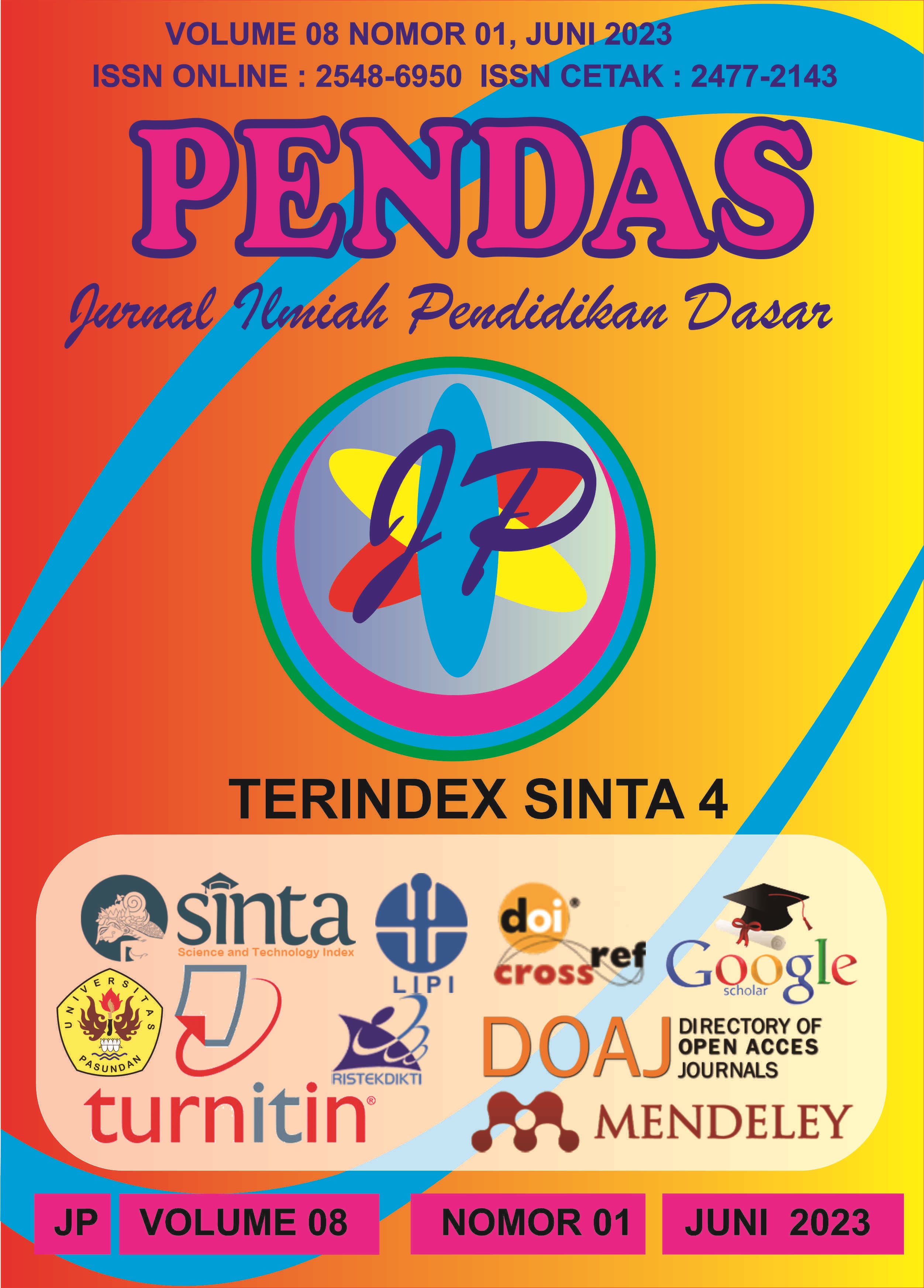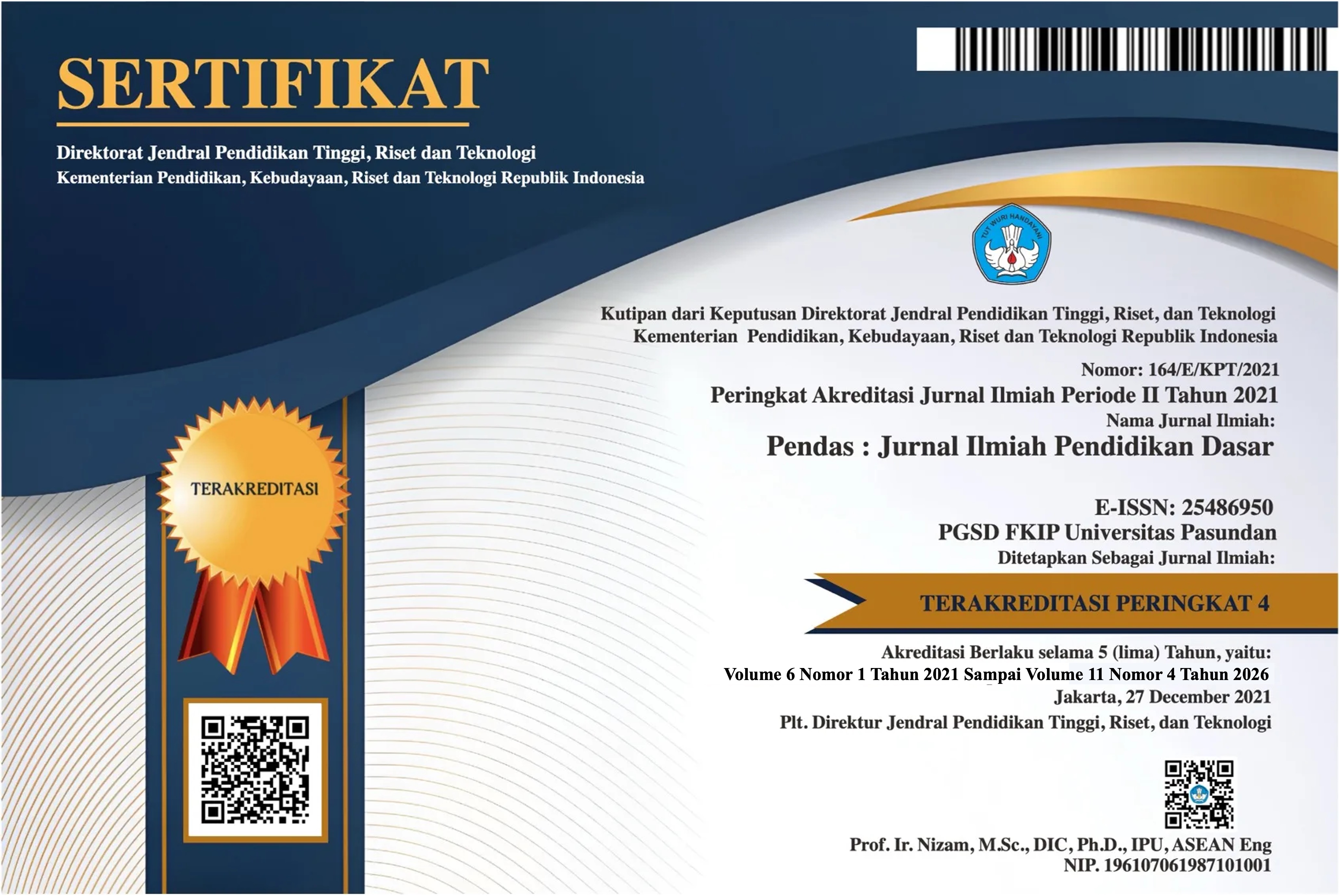PENGARUH MODEL PEMBELAJARAN KOOPERATIF NUMBERED HEADS TOGETHER (NHT) TERHADAP KERJASAMA Dan PEMAHAMAN SISWA PADA MATA PELAJARAN IPA KELAS V
DOI:
https://doi.org/10.23969/jp.v8i1.8979Keywords:
Numbered Heads Together (NHT), Cooperation, UnderstandingAbstract
This study aims to see the effect of the numbered heads together learning model on the cooperation and understanding of fifth grade students in science content. The approach used in this research is a quantitative approach with a descriptive approach. The data collection method used in this study was a questionnaire (questionnaire) and test questions. By using the one group pretest posttest, use this questionnaire to measure student cooperation. and test questions to measure student understanding. The data analysis method used in this study is the validity and reliability test, data normality, and the paired sample T-test. Based on the results of the study, it showed that there was an influence of the numbered heads together cooperative learning model on the cooperation and understanding of students in science subjects in grade V UPTD SDN Pernajuh as seen based on pretest and posttest data. It is known that based on the output that has been tested, it is obtained from the description of the data that there is an average mean of student cooperation in the pretest 44.56 and posttest data 52.30. And on students' understanding, the average mean at pretest is 84.34 and at posttest is 95.00. There is an influence of the numbered heads together (NHT) cooperative learning model on cooperation and understanding of fifth grade students of UPTD SDN Pernajuh. It is known that significant value data on equal variances assumed is 0.000 <0.05 on the paired sample t-test of cooperation, and significant value data on equal variances assumed is 0.003 <0.05 on the paired sample t-test of students' understanding.Downloads
References
Abdul, K. (2015). Menyusun Dan Menganalisis Tes Hasil Belajar. Al Ta’dib, 8(2), 70–81.
Agustinus Hari Hanggara, Imanuel Sairo Awang, B. (2016). Pengaruh Model Pembelajaran Numbered Heads Together Terhadap Hasil Belajar. Jurnal Pendidikan Dasar PerKhasa, 2(April), 80.
Arenita, C. F., Prasetiyo, & Budiman, M. A. (2018). Pengaruh Model Pembelajaran Numbered Head Together (NHT) Terhadap Hasil Belajar Dan Keaktifan Siswa Pada Mata Pelajaran IPA Kelas V SDN 3 Dokoro Wirosari. JGK (Jurnal Guru Kita), 2(4), 76–82.
Deliany, N., Hidayat, A., & Nurhayati, Y. (2019). Penerapan Multimedia Interaktif untuk Meningkatkan Pemahaman Konsep IPA Peserta Didik di Sekolah Dasar. Educare, 17(2), 90–97. http://jurnal.fkip.unla.ac.id/ind x.php/educare/article/view/24
Fauziddin, M. (2016). Paud Tambusai. Paud Tambusai Pgpaud Stk, 2 Nomor 1, 29 45.
Gogik, B. (2022). Penerapan Model Numbered Head Together ( Nht ) Terhadap Hasil Belajar Ipa Siswa Kelas IV SD Negeri 42. 9(2), 26–33.
Karitas, D. P. (2017). Ekosistem. Buku tematik terpadu kurikulum 2013 (Tema 5), buku guru SD/MI Kelas V. http://repositori.kemdikbud.go d/id/eprint/7034
Mairina, V., & Amini, R. (2021). Peningkatan Hasil Belajar IPA Melalui Model Pembelajaran Kuantum di Sekolah Dasar. Jurnal Basicedu, 5(2), 784 788. https://doi.org/10.31004/basic du.v5i2.766
Muhammad Aris, A. (2014). Mengembangkan Karakter Pembelajaran Model Kooperatif Tipe Number Head Together. Title. Lincolin Arsyad, 3(2), 1–46. http://journal.stainkudus.ac.id/ ndex.php/equilibrium/article/v w/1268/1127
Nasution, S. (2017). Variabel penelitian. Raudhah, 05(02), 1–9. http://jurnaltarbiyah.uinsu.ac.i /index.php/raudhah/article/vie /182.
Ningrum, M. F. C. P., Slameto, Widyanti, E. (2018). Upaya Meningkatkan Keterampilan Kerjasama Siswa pada Bidang Studi IPA Melalui Penerapan Model Group Investigation bagi Siswa Kelas 5 SDN Kumpulrejo 2. Wahana Kreatifitas Pendidik, I(3), 7–13.
Prananda, G., & Hadiyanto. (2019). Korelasi Antara Motivasi Belajar dengan Hasil Belajar Siswa dalam Pembelajaran IPA di Sekolah Dasar. Jurnal Basicedu, 3(3), 909–915.
Prof. Dr. Sugiyono. (2015). Metode Penelitian Kuantitatif. Penerbit Alfabeta: Bandung.
Putra, I. B. P. A., Pujani, N. M., & Juniartina, P. P. (2018). Pengaruh Model Pembelajaran Kooperatif Tipe Jigsaw Terhadap Pemahaman Konsep Ipa Siswa. Jurnal Pendidikan Dan Pembelajaran Sains Indonesia (JPPSI), 1(2), 80. https://doi.org/10.23887/jppsi. 1i2.17215
Sayekti, I. C. (2019). Analisis Hakikat Ipa Pada Buku Siswa Kelas Iv Sub Tema I Tema 3 Kurikulum 2013. Profesi Pendidikan Dasar, 1(2), 129–144. https://doi.org/10.23917/ppd.v i2.9256
Suandewi, K., & Citra Wibawa, I. M. (2017). Penerapan Model Pembelajaran Numbered Head Together Meningkatkan Hasil Belajar Ipa Siswa Kelas Iv Sd No. 3 Kapal. Jurnal Ilmiah Sekolah Dasar, 1(1), 59. https://doi.org/10.23887/jisd.v i1.10116
Syamsuryadin, S., & Wahyuniati, C. F. S. (2017). Tingkat Pengetahuan Pelatih Bola Voli Tentang Program Latihan Mental Di Kabupaten Sleman Yogyakarta. Jorpres (Jurnal Olahraga Prestasi), 13(1), 53 59. https://doi.org/10.21831/jorpr s.v13i1.12884
Vivi Muliandari, P. T. (2019) Pengaruh Model Pembelajaran Kooperatif Tipe NHT (Numbered Head Together) Terhadap Hasil Belajar Matematika. International Journal of Elementary Education, 3(2), 132. https://doi.org/10.23887/ijee.v i2.18517
Downloads
Published
Issue
Section
License
Copyright (c) 2023 Pendas : Jurnal Ilmiah Pendidikan Dasar

This work is licensed under a Creative Commons Attribution 4.0 International License.



















